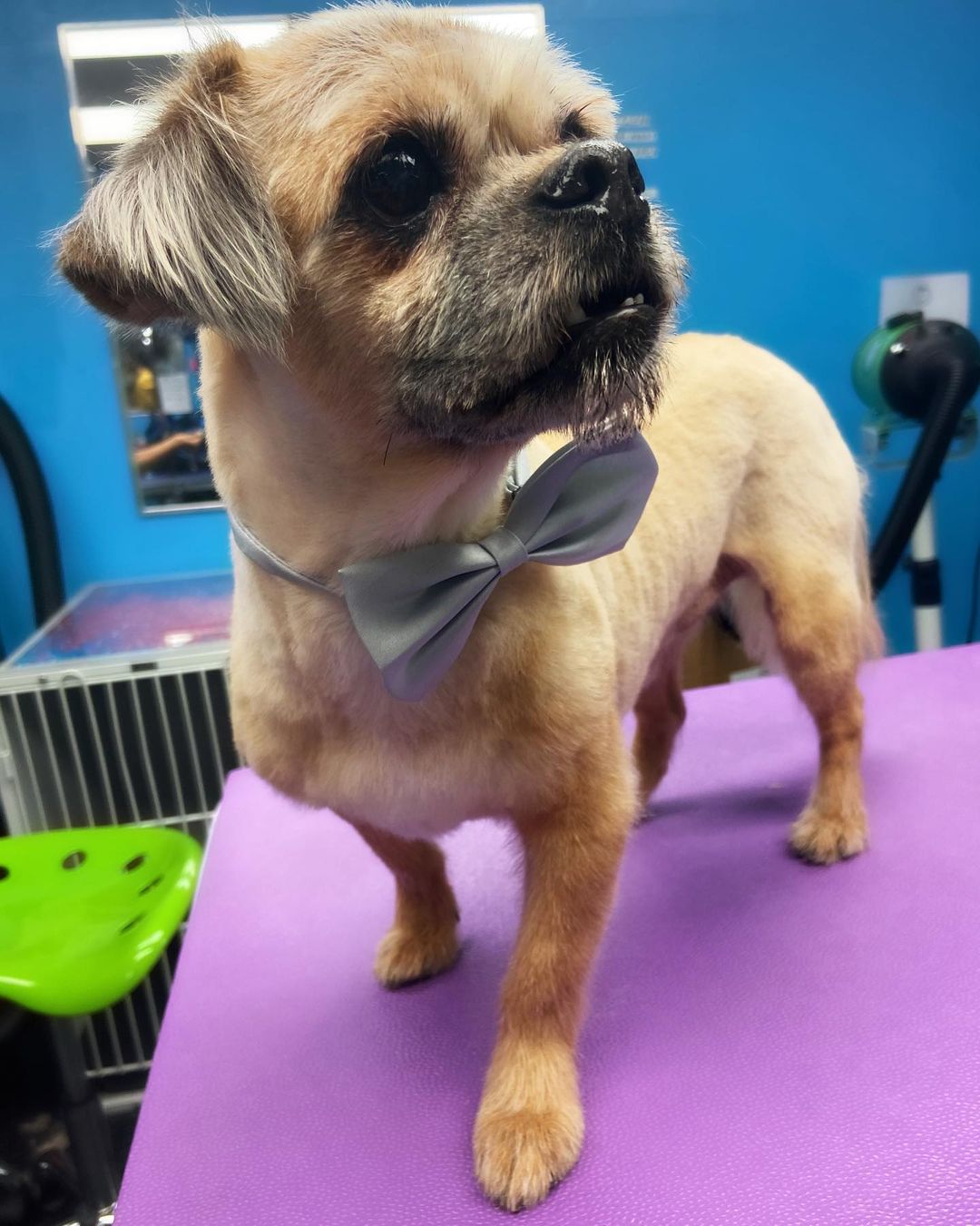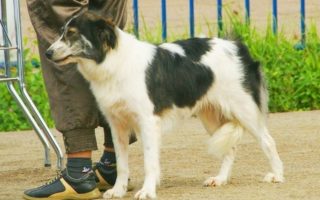Statistics never lie!
Judging by the numbers, dogs are the most favorite pets among most homeowners in the USA.
And why wouldn’t they be?
Their charming temperament and sense of humor make most of us fall more in love with these furry loyal canines with every passing day.
So, if you are also planning to adopt a Samoyed dog, and you cannot help but ask, ‘Are Samoyeds good family dogs?’ then worry not as I got you covered through this article.
Please make sure that you read up to the end of this article as it captures all the details you need to know about a Samoyed’s ability to make an excellent family dog.
I will also walk you through the qualities that make a dog to be a good family dog, and how to successfully introduce your new Samoyed to your family.
And if you already have other pets or animals in your house and you are wondering if Samoyeds are good with other animals, then ease your mind as I also got you covered.
[wpsm_toplist]
Are Samoyeds Good Family Dogs?
Yes, Samoyeds make excellent family dogs with early socialization and training. They are loyal, protective, tolerant, playful, outgoing, kid and pet friendly.
When adopted in a caring and loving family, all these personality values attribute to Samoyed’s gentle and lovable nature, thus making them exceptional family dogs.
What Makes A Good Family Dog?
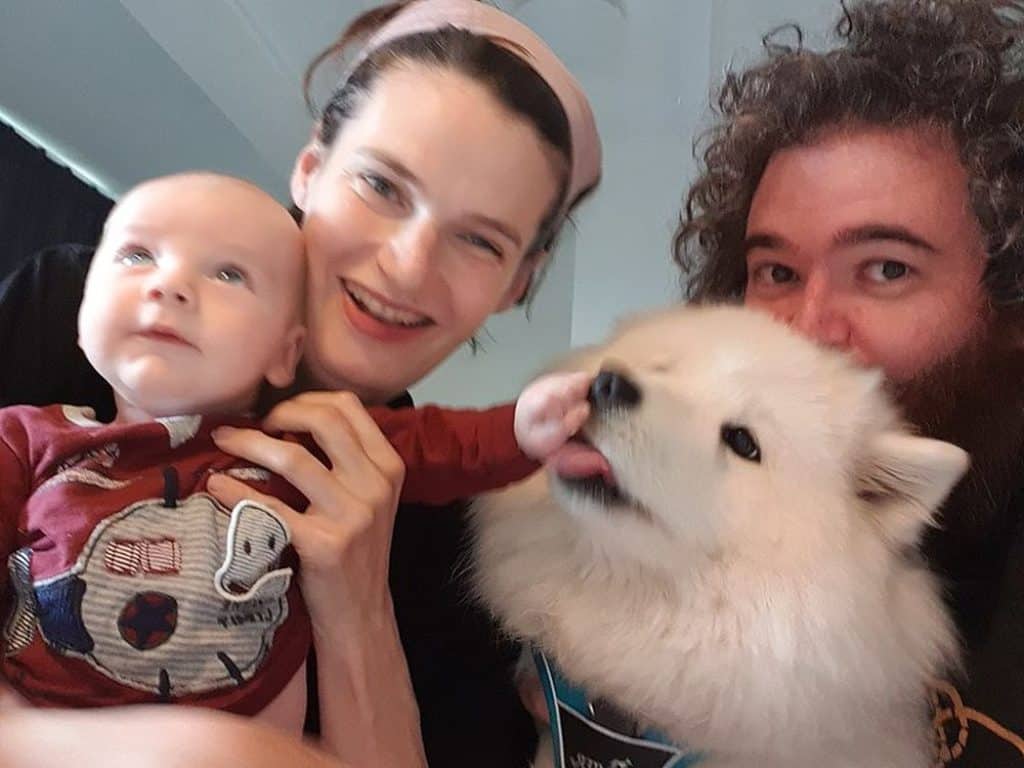
Loyalty And Devotion
An ideal family dog should be both loyal and devoted to its family. Whether in terms of physical or emotional devotion.
Your dog should not give you any reason to doubt its loyalty.
So if you adopt a dog and it spends most of its time trying to escape, or in your neighbors compound, it’s safe to assume that your dog isn’t loyal to you.
Pro-tip; You can train your hound to be loyal to you and your family by first letting it have trust in you through providing it with enough water, food, a clean and safe place to stay, and protecting it.
Outgoing
A good family dog should not be reserved or shy.
It should be confident enough to make friends, let others cuddle it, or even show its affection to both different people and animals around it.
An outgoing dog tends to socialize much faster than a shy and introverted dog.
Kid And Pet Friendly
A family comprises of many individuals. It doesn’t have to be only your friends, relatives, or kids but it can also be other pets or animals around you.
A good family dog should be both kid and pet-friendly.
This is usually manifested by its ability to tolerate and still be friendly to kids and pets who constantly ‘bother’ it.
Protective
One innate personality trait of a dog is to protect those it loves.
So, if your dog can’t portray any protective behaviors when your family is threatened or in danger, then that hound should not be considered fit to be adopted as a family dog.
Adaptability
A good family dog should be able to adapt to both your living conditions and living styles.
PS; This doesn’t mean that you subject your hound to harsh conditions or environment, all in a bid to determine whether or not it will make a good family dog.
Remember, dogs also have limits to what they can withstand or tolerate.
Easy To Train Or Intelligent
Living with a dog can sometimes be quite tricky.
You have to train it not to play rough with the kids, not to urinate or poop in the undesignated area, not to chew on your beddings or furniture, and not to bark unnecessarily.
This makes it essential that a family dog be intelligent or easy to train.
Independent
No one loves an excessively clingy dog, especially if you have chores and errands to run.
An independent dog will give you space to do what you need to do to keep your family going. On the other hand, a dependent dog will make your life a bit difficult.
Either by ‘smothering’ you, following you around, or turning into destructive behaviors each time you leave it on its own.
Hypoallergenic
The primary purpose of adopting a dog is to improve your family’s life quality and not lower it by predisposing your loved ones to health conditions caused by dog dander or hair.
So, consider getting your family a hypoallergenic dog as your family dog.
How Do You Introduce A New Samoyed To Your Family?
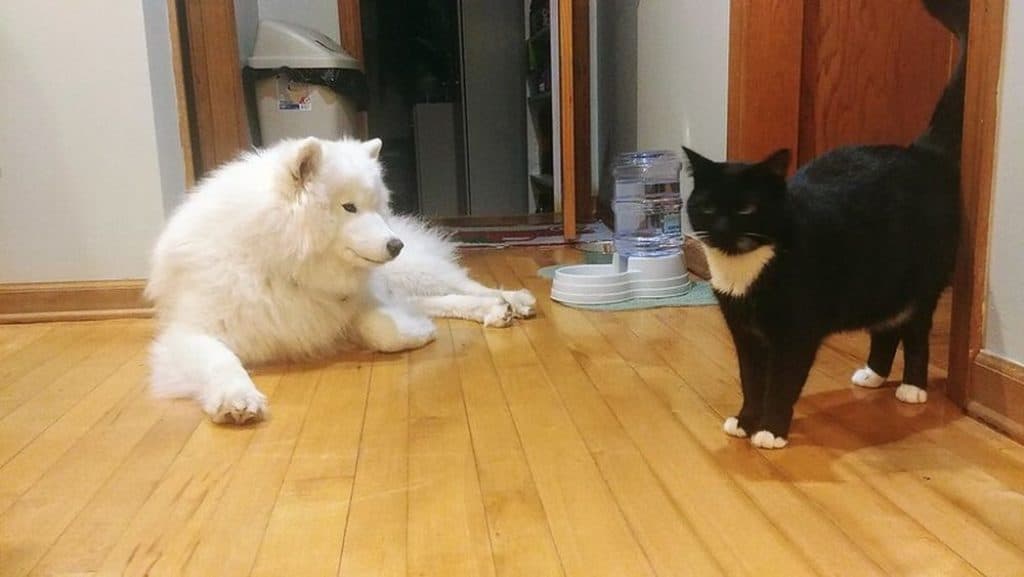
To Your Cat
Have 2 rooms fitted with enough water, food, toys, and litter boxes prepared for both your cat and dog.
Let your dog explore your cat’s room and vice versa; this helps the 2 get used to each other’s scents.
Please do this for 2 weeks, before you proceed to let them meet without physically touching.
Consider using a leash on your Samoyed and allowing the cat to move around without any restrictions.
Let this be an open area to provide distractions to both your dog and cat. Do this for a week until you are satisfied that both 2 are ready to interact physically.
Ensure that the actual physical interaction takes place in an enclosed room with enough lighting and ventilation.
I recommend that you have a friend around to help you out, just in case the physical interaction doesn’t turn out positively.
Have your dog put on a durable and resistant to rip collar and leash.
If the physical interaction turns out to be a success, monitor the 2 for at least 3 weeks before letting them play, eat or spend time together without superstition.
To Your Other Dog(s)
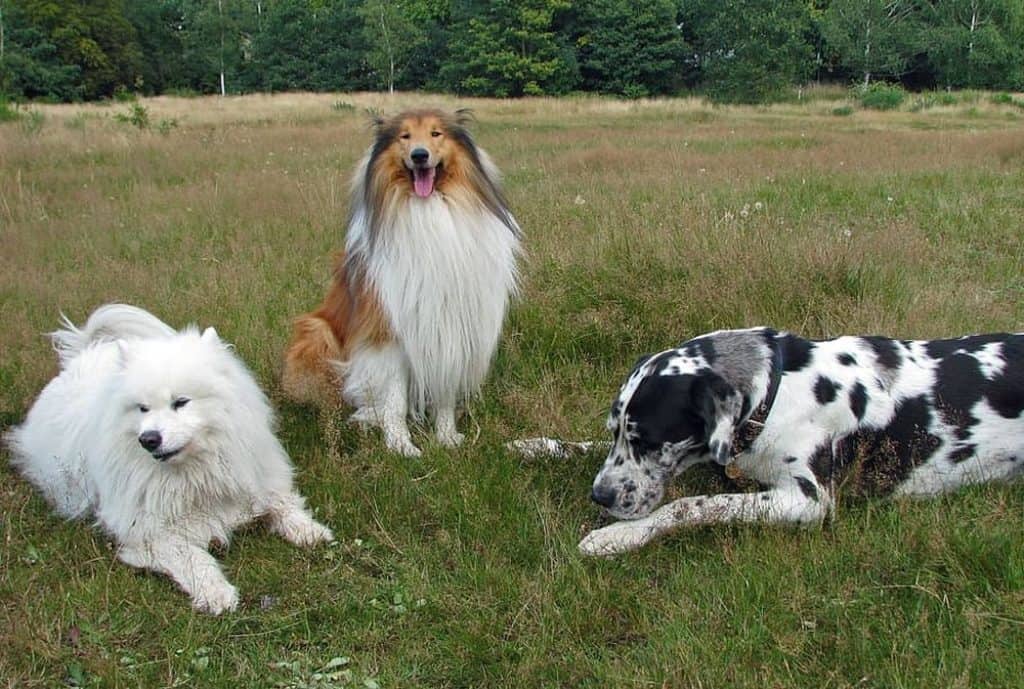
Introducing your new Samoyed to a resident dog can be pretty challenging, especially if the 2 don’t complement each other in terms of personality.
So be sure to adopt a dog that is friendly, energetic, outgoing, and loyal, just like your Samoyed.
Pro-tip; It’s always recommended that you adopt a dog of the opposite gender to your resident dog to avoid territorial dominance.
If you don’t want to be a pup parent after 3 months, ensure that you control your doggies’ breeding urges by having them spayed or neutered by your vet.
Things you can do to make the introduction between the 2 hounds successful;
Let the 2 dogs meet without physically touching; you can do this by having a friend or your family member help you walk the resident dog while you walk the new dog.
Maintain a physical distance of 2 meters during the walk. Give both dogs equal attention.
Place their feeding bowls in the same room but in separate locations. Don’t let any of the dog eat the other’s food or drink the other’s water.
Teach them the basic’ No’ command to deter development of unwanted behavior in either of the 2 hounds.
To Your Kid(s)
Introducing your Samoyed to your kid is such a big deal, as this will determine whether or not your new dog gets to stay with you in your home permanently.
You cannot afford to leave your hound with your kid(s) if you are unsure of what might transpire while you are away.
Below are easy steps on how to successfully introduce your new Samoyed to your kid(s) or toddler;
Let Your Kid(s) Know
Before bringing your new hound home, talk to your kids if they are old enough to understand.
Let them know that you are about to bring a dog home.
Unless you want to surprise them, but even then, indirectly tell them what you would expect them to do if you were to theoretically adopt a family dog.
Have Your Kid(s) Know What Your Samoyed’s Dislikes
Let your child know dogs dislike being hugged and that hugging a dog may lead to unwanted bites.
Also, ensure that you discourage your kid from pulling your hound’s ears, fur, or tail.
Don’t forget to remind them not to play rough with your Samoyed or invade its personal space when it’s resting.
Let Your New Hound Get Used To Your Kid(s) Scent Without Any Physical Interaction
Samoyed’s form bonds through scents. Consider placing your kids’ favorite toy in your hound’s cage.
You can also place your child’s blanket in your dog’s room or crate.
During this time, don’t let your hound physically meet your kid until you are sure it is used to your kid’s smell/scent.
Organize A Supervised Physical Interaction
After you are sure your kid understands what is expected of them during a physical meet-up with the new family dog, you can organize a physical interaction.
Use a leash to control your Samoyed’s movement. Allow your dog to sniff or lick your kid, provided it doesn’t harm them in any way.
Do this for at least 3 weeks before leaving your child with the dog unsupervised.
Pro-tip; If your kid is old enough, let them take part in feeding your hound, playing with it, or walking it around on a leash.
Be sure to also hold the leash as Samoyeds are quite strong and may easily injure your child due to a forceful pull, which may be both intentional and non-intentional.
Letting your child do all this will speed up the socialization process between your child and your Samoyed.
To An Adult(s) Member Of The Family

This is usually easy, especially if your significant other or family member(s) has ever owned a dog.
Use a leash to control your dog’s movement.
Let it sniff, lick or physically touch the new person, as long as it is not displaying any aggressive behavior(s).
To fasten the introduction, you can have the person feed your dog treats. This should only be done if your dog is receptive to the new person feeding it.
Note! Female Samoyeds tend to be more territorial than male Samoyeds.
So, during a physical meet-up, ensure that you select a neutral place, which your dog doesn’t consider its territory.
This helps reduce any chances of your Samoyed getting physically aggressive with the new person just because it feels its territory is being invaded.
Are Samoyeds Good For First Time Owners?
No, Samoyed’s are not a good fit for first-time dog parents.
Their almost dependent nature and stubbornness make them more of a good fit for an experienced dog owner who can handle these types of temperaments in Samoyeds.
But if you really feel that the Samoyed is the right dog breed for you and your family despite being a first-time dog parent, then consider hiring a professional dog trainer or an animal behaviorist.
And let them help you bring up a Samoyed with desirable social and physical behaviors.
Are Samoyeds Good With Other Animals?
Yes, Samoyeds are good with animals provided that they are thoroughly socialized at a young age.
However, a good-mannered Samoyed can portray aggressive behaviors toward other animals or pets it has been living with in harmony.
The most common causes that can make a Samoyed act this way include;
Stress, fear, pain, underlying medical conditions, or the innate herding instincts that make it want to be the boss of all the animals around it.
If you notice such a change in your obedient and peaceful hound, I recommend you find out what’s triggering these undesirable behaviors and eliminate them.
If you are unable to, please call in for the services of an animal behaviorist specialist and let them help you reverse your confrontational Samoyed to its gentle and calm nature.
Are Samoyeds Good Family Dogs? – Conclusion
Are Samoyeds good family dogs? Yes, Samoyeds make good family dogs even with minimal training.
They are outgoing, protective, kid-friendly, tolerant, patient, affectionate, nonaggressive, and energetic in nature.
All these qualities contribute to their ability to make excellent family dogs.
When introducing a new Samoyed to your family, please exercise patience and tolerance.
Go with your dog’s pace to avoid overwhelming it.
Always avoid forced interactions between your hound and those you are introducing it to.
Ensure that your kid(s) know what is expected of them during your dog’s introduction.
Supervise the physical interaction for at least 2-3 weeks to determine whether or not the newly formed bond is genuine or forced.
Samoyeds are not a good fit for first time owners.
However, hiring the services of a professional dog trainer despite being a novice dog parent can help you shape and peacefully live with a Samoyed as your family pet.
These dogs breed patience, tolerance, outgoing and friendly nature makes them able to adapt quickly to living with different animals around a home.

